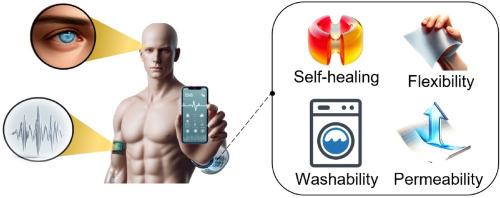Biomaterials for reliable wearable health monitoring: Applications in skin and eye integration
IF 12.8
1区 医学
Q1 ENGINEERING, BIOMEDICAL
引用次数: 0
Abstract
Recent advancements in biomaterials have significantly impacted wearable health monitoring, creating opportunities for personalized and non-invasive health assessments. These developments address the growing demand for customized healthcare solutions. Durability is a critical factor for biomaterials in wearable applications, as they must withstand diverse wearing conditions effectively. Therefore, there is a heightened focus on developing biomaterials that maintain robust and stable functionalities, essential for advancing wearable sensing technologies. This review examines the biomaterials used in wearable sensors, specifically those interfaced with human skin and eyes, highlighting essential strategies for achieving long-lasting and stable performance. We specifically discuss three main categories of biomaterials—hydrogels, fibers, and hybrid materials—each offering distinct properties ideal for use in durable wearable health monitoring systems. Moreover, we delve into the latest advancements in biomaterial-based sensors, which hold the potential to facilitate early disease detection, preventative interventions, and tailored healthcare approaches. We also address ongoing challenges and suggest future directions for research on material-based wearable sensors to encourage continuous innovation in this dynamic field.

用于可靠的可穿戴健康监测的生物材料:皮肤和眼部一体化应用。
生物材料的最新进展对可穿戴健康监测产生了重大影响,为个性化和无创健康评估创造了机会。这些发展满足了人们对定制化医疗解决方案日益增长的需求。耐久性是可穿戴应用中生物材料的一个关键因素,因为它们必须能有效承受各种穿戴条件。因此,人们更加关注开发能够保持强大和稳定功能的生物材料,这对推动可穿戴传感技术的发展至关重要。本综述探讨了可穿戴传感器中使用的生物材料,特别是与人体皮肤和眼睛连接的生物材料,强调了实现持久稳定性能的基本策略。我们特别讨论了三大类生物材料--水凝胶、纤维和混合材料--每一类材料都具有不同的特性,非常适合用于耐用的可穿戴健康监测系统。此外,我们还深入探讨了基于生物材料的传感器的最新进展,这些传感器具有促进早期疾病检测、预防性干预和定制医疗方法的潜力。我们还探讨了当前面临的挑战,并提出了基于材料的可穿戴传感器的未来研究方向,以鼓励这一充满活力的领域不断创新。
本文章由计算机程序翻译,如有差异,请以英文原文为准。
求助全文
约1分钟内获得全文
求助全文
来源期刊

Biomaterials
工程技术-材料科学:生物材料
CiteScore
26.00
自引率
2.90%
发文量
565
审稿时长
46 days
期刊介绍:
Biomaterials is an international journal covering the science and clinical application of biomaterials. A biomaterial is now defined as a substance that has been engineered to take a form which, alone or as part of a complex system, is used to direct, by control of interactions with components of living systems, the course of any therapeutic or diagnostic procedure. It is the aim of the journal to provide a peer-reviewed forum for the publication of original papers and authoritative review and opinion papers dealing with the most important issues facing the use of biomaterials in clinical practice. The scope of the journal covers the wide range of physical, biological and chemical sciences that underpin the design of biomaterials and the clinical disciplines in which they are used. These sciences include polymer synthesis and characterization, drug and gene vector design, the biology of the host response, immunology and toxicology and self assembly at the nanoscale. Clinical applications include the therapies of medical technology and regenerative medicine in all clinical disciplines, and diagnostic systems that reply on innovative contrast and sensing agents. The journal is relevant to areas such as cancer diagnosis and therapy, implantable devices, drug delivery systems, gene vectors, bionanotechnology and tissue engineering.
 求助内容:
求助内容: 应助结果提醒方式:
应助结果提醒方式:


